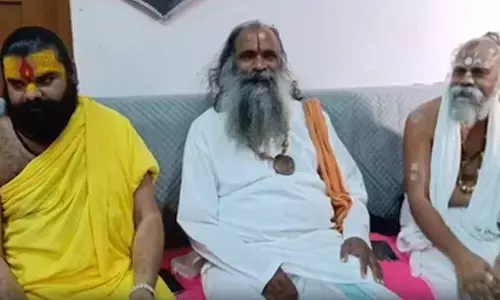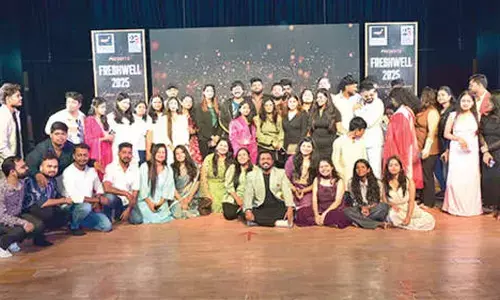An Illustrious journey

An Illustrious Journey. Shekar’s cartoons have a native Telugu flavour. The idea, punch and style are distinctly different from others. His cartoons have a special grammar and glamour as well.
Remember the cartoon in a vernacular daily on the infamous pepper spray incident in Lok Sabha recently? A woman, depicted as ‘Democracy’ running out of Parliament screaming and rubbing her tears; and a hand from the pillars of the edifice coming out with a bottle and spraying pepper on her… It was named as “Pepper swamyam” (punning on prajaswamyam- Democracy)!This thought-provoking cartoon on how democracy is being murdered inside Parliament was sketched by Shekar, who completed 25 years of illustrious journey in political cartoon sphere.
.jpg) Shekar’s cartoons have a native Telugu flavour. The idea, punch and style are distinctly different from others. His cartoons have a special grammar and glamour as well. His strong leftist roots coupled with an authority over Telugu literature gave him a firm grounding in the field that he loves as much. Says Kambalapally Chandra Shekar, better known as Shekar: “A political cartoonist should have complete command over political developments, the inside stories and hidden agendas. He should be a writer, a painter, a cameraman who can visualise from his prism…all in one.”
Shekar’s cartoons have a native Telugu flavour. The idea, punch and style are distinctly different from others. His cartoons have a special grammar and glamour as well. His strong leftist roots coupled with an authority over Telugu literature gave him a firm grounding in the field that he loves as much. Says Kambalapally Chandra Shekar, better known as Shekar: “A political cartoonist should have complete command over political developments, the inside stories and hidden agendas. He should be a writer, a painter, a cameraman who can visualise from his prism…all in one.”
His association with People’s War Group, Praja Natya Mandali, PDSU and other left-wing groups helped him understand the society, the struggles, the chasm between the haves and have-nots and the life of the underprivileged.
He hails from Suryapet in Nalgonda district. He started his career by sending cartoons to some magazines and dailies during his student days. “Leftist organisations were very popular in Nalgonda district and they used to own up people who have artistic views and ideological similarities. I used to write slogans with pictures on walls make posters and prepare pamphlets for them. I imbibed Marxist ideology and studied everything in the light of Marxism during my college days. Later, with an interest on Telugu literature, I joined M A (Literature) at Kakatiya University and I had had the good fortune of having legends like Ketavarapu Ramkoti Sastry, Katyayani Vidmahe, Kovela bothers etc as my gurus. After reading some classics of Telugu literature, I used to make caricatures of familiar mythological, folk and social figures,” Shekar relates.
.jpg)
His passion for cartoons has no bounds. Even when he was jobless, he did not stop drawing cartoons. To realise his dream of getting his cartoons published, he decided to shift to Hyderabad. But he could not even afford boarding. He joined LLB at Osmania University just for the sake of hostel accommodation. He arranged his cartoon exhibitions in two hostel buildings and on one occasion Vinay Kumar, who later became the editor of Prajashakti newspaper, happened to visit it. He was quite impressed with the line and offered Shekar a job at Prajashakti.
 “I appeared for a few written tests for clerical jobs conducted by APPSC. I would have got some but I was not interested. I decided to continue as a cartoonist. I had joined Praja Shakti as political cartoonist-cum-sub editor at Vijayawada in late 1980s. My leftist leanings helped me a lot in my work and I won appreciation from one and all within no time. But I had to work there for a paltry amount and after a six-year stint, I moved over to Andhra Prabha where I worked for seven years and later with Indian Express for three years. I switched over to Andhra Jyothy later as I needed money to meet my growing responsibilities. Since then I have been working there.”
“I appeared for a few written tests for clerical jobs conducted by APPSC. I would have got some but I was not interested. I decided to continue as a cartoonist. I had joined Praja Shakti as political cartoonist-cum-sub editor at Vijayawada in late 1980s. My leftist leanings helped me a lot in my work and I won appreciation from one and all within no time. But I had to work there for a paltry amount and after a six-year stint, I moved over to Andhra Prabha where I worked for seven years and later with Indian Express for three years. I switched over to Andhra Jyothy later as I needed money to meet my growing responsibilities. Since then I have been working there.”
Relating the varied experiences of working with different news dailies, “Praja Shakti is a party organ. They have a specific line. Andhra Prabha treads a cautious path and we should act accordingly. Andhra Jyothy too has political policy and I need to satisfy it. So, I can tell you that a political cartoonist has lost freedom in the changing world where editorial policies are being redefined. I do not find fault with anyone. One has to tune himself to the needs of changing times. That’s it.”
Shekar was a stauch follower of eminent cartoonist RK Lakshman. He studied not just the Lakshmanrekha (line) but the way the celebrated cartoonist depicts political views in his toons. “I met him once and told him that I was his Ekalavyasishya. He promptly retorted saying that he was not Dronacharya to take away my finger. That’s Lakshman.”
Shekar admitted to have imitated other cartoonists from the West. “I liked Sergio Aragones of the US. In the same breath, I like the caricatures of Thomas Naste, Ann Telnaes, Derryl Cagle.”
With the passage of time, Shekar’s brush has also sharpened. “Yes, my line was rather ungentle, brusque and hard 20 years ago. With the advent of new tools, brushes and changing colours, it has sharpened” he said.
He prefers his cartoons and caricatures to be thought-provoking rather than drawing instant laugh. “In fact, the very nature of political cartoons is to be thought-provoking. I love satire more than just humour. You can see that 99 percent of my cartoons have some degree of satire, mockery, sarcasm, comment or whatever you may call it. I never draw cartoons for the sake of just laughing. Cartoons are my breath, my life, my light and a source of inspiration for my life” explains shekar with a sense of ecstasy.
But Shekar fears that political cartoons may one day become extinct due to the business outlook of media tycoons. “With the advent of Internet, images relevant to the stories are readily available. Tell me how many editors nowadays stand by cartoonists whenever any controversy erupts? News dailies have individual agendas and the cartoonists have to draw in tune within their demands. They have to exhibit their talent within that contour. Such cartoons neither make you laugh nor are thought-provoking. If any cartoonist says that he has 100 percent freedom, it is nothing but hypocrisy,” he laments.
“Cartoon is just a masala item in a newspaper now. It is being continued for the sake of taste. If some other tasty dish is found tomorrow, this will be totally lifted. You can see that the space that is being allotted to political cartoons has been slowly shrinking. The quality of cartoons too has been degrading. The managements love fun or entertainment rather than stimulating interest,” he adds.
.jpg)
“A signal to the demise of political cartoons is felt now as none in the present generation takes it up as their job. Youngsters turn to animation or graphics because as they find no future here.”
How did this happen? When the competition was removed and the once-proud and principled newspaper fell into the hands of greedy chains, or clueless business lords, bottom-line journalism was born. This heralded the beginning of the death of Controversy. Controversy, that life force behind the political cartoon, is of course completely anathema to those nursing the books: when you are making 20 to 30 percent on your investment annually, there’s no point in making waves. Shekar fully endorses this view fully.
By far, Shekar drew a whopping 46,000 cartoons of all types in addition to a number of general illustrations for stories, books etc., in his 25-year-long journey. He took Telugu cartoon to international level by representing in the AAEC (Association of American Editorial Cartoonists) conclave held in the US in 2011. He, along with Manjil of DNA represented India and he shared his thoughts with the cartoonists of Africa, Asia, Europe and US. That was shining moment in his life.
Shekar is currently ailing from Cancer but it did not deter his will power and he has been working 24x7 from home. A man with grit and determination, he published five books so far and another one exclusively on casteism is ready to be printed. Perhaps he is the only cartoonist in Andhra Pradesh who could draw cartoons on the contentious Telangana Movement.


















